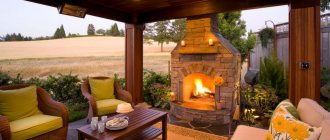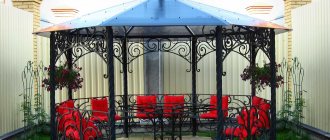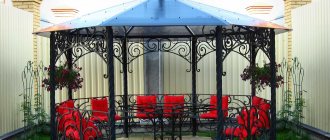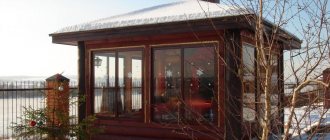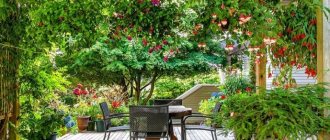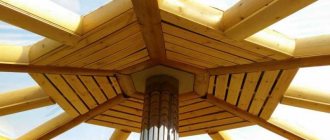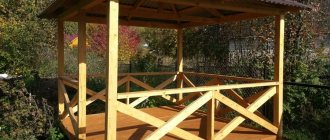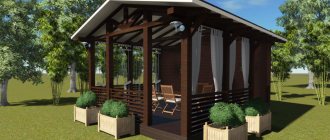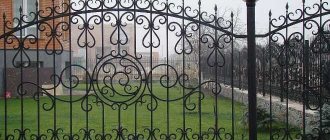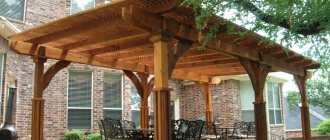A landscaped garden is not just about beautiful plants. To fully enjoy your property, you need to take care of the yard equipment. Small architecture should decorate the garden next to the flowers and make the landscape more cozy and comfortable. A garden gazebo is a place where you can hide from the sun or rain, and also store a lot of things. There are several types of garden gazebos. Forged metal models are distinguished by their special aesthetics. Manufacturers are surpassing each other in creating more and more beautiful and interesting designs. Consider the beautiful wrought-iron gazebos in the photos presented for your dacha or home.
Advantages of forged gazebos
When choosing gazebos and garden furniture, you should take into account not only aesthetic, but also practical characteristics:
- durability of the material from which they are made;
- need for maintenance;
- weather resistance.
Today, different gazebos are available in the market. They are characterized by high strength and do not require frequent maintenance. Forged gazebos are exactly what they are, because users can relax in them without wasting time on labor-intensive painting and structural repairs.
Wrought iron gazebos are an investment that pays off. First of all, they are practically indestructible, resistant to any mechanical damage such as scratches. Their advantage is also the fact that iron gazebos perform perfectly in the garden, allowing the user to enjoy remarkable style and workmanship, blending harmoniously into the landscape, for example, in an industrial style or a more traditional one.
When choosing gazebos, it is worth paying attention to how they are made, for example, whether they are made by hand and whether the final product is properly protected from corrosion and rust during the production process.
Types of forged gazebos
Massive structures installed on a solid foundation. Suitable for spending time even at low temperatures. It is possible to install a barbecue or fireplace.
These gazebos are more like outbuildings. Additional charm is provided by wrought iron windows and multi-colored stripes on the roofs, which today are often made of polycarbonate.
Light openwork design, it protects only from rain and sun, but gives the garden a sophisticated look. These are products that most closely resemble works of art; they delight the eye with their light delicacy and weightlessness.
Open or closed gazebos set the style of the dacha and become its main decoration due to the variety of shapes: tents, domes, pagodas - all this only emphasizes the unusualness of landscape solutions.
Impressive design and durability for many years
Wrought iron gazebos are characterized by durability, careful workmanship, rich designs and colors. In addition, due to the fact that the products are handmade, powder-coated and patinated, you will be able to use the forged gazebo for many decades, passing it on by inheritance.
It should also be noted that garden gazebos intended for outdoor use are galvanized, which can be both decorative and protective, increasing resistance to adverse external factors. Only later are they painted using the powder method, which almost forever protects them from corrosion. Thanks to this, forging also does not require special maintenance from users.
Shape selection
It is preferable to choose the configuration of the garden gazebo, taking into account the appearance of nearby buildings and, of course, the free area of the territory. Please note that the capacity of the gazebo will depend on the shape; consider how many people will be accommodated inside it.
There are gazebos with forged parts of several shapes to choose from, most often they are square, rectangular, and less often oval structures. Multifaceted models are also available.
Rectangular structures are suitable for organizing parties and can accommodate many people. Inside such a gazebo you can place a long table and small sofas for greater comfort.
Oval-shaped gazebos, along with round ones, have smooth lines; they are often decorated with greenery. In such models, it is most convenient to place a table with a barbecue in the center.
To order, you can make a gazebo with a non-standard configuration. Custom-made gazebos, as a rule, have a fancy design, with transitions between compartments located on different sides of the site. Such structures accommodate more people than conventional models.
Forged gazebos with barbecue: photos and prices
Arrangement of a forged gazebo
A wrought iron gazebo can be complemented with many other materials, allowing for an almost unlimited number of designs. For example, metal tables are very popular. Often clients decide to combine gazebos and wrought iron furniture with granite or wood. The most successful solution is folding chairs combined with wooden slats, which break the rather harsh style of the wrought iron gazebo, combining it with natural wood. Plastic is suitable as a budget option.
Building materials for wrought iron construction
Wrought iron gazebos for summer cottages are made using the following materials:
- Iron;
- Copper products;
- Steel structures.
Metal craftsmen use soft alloys containing carbon up to 13% of the total mass. If the proportion of carbon is increased, it will interfere with the common forge welding, and will also increase the hardening of steel, which will create difficulties in artistic forging.
In the case of machine forging, square or round profiles, sheet material, and stamping sheet are used. In manual processing, the latter option is absent. It is difficult to find designs with only one option. Most often, the gazebo carries elements of both the first and second technologies.
Manufacturing of forged elements
Features of manufacturing forged gazebos
Today you can choose gazebos in different colors from a wide palette. In addition to the base tone, you can also paint the furniture in the color of your choice. This option is available from almost every manufacturer. All wrought iron gazebos are made upon request. Companies produce designs based on individual customer projects, selecting the final product according to the most sophisticated wishes. In addition to our wide selection of wrought iron furniture, you can consider other types of metalwork, both black and stainless steel, including carved balustrades and fences.
Phased construction of a gazebo 3x5.4 m
The first step is to take care of the design of the roof. For this you will need:
- pipe 20x40 mm, 2 m long - 12 pcs.;
- transverse pipes of the same diameter, 3 m long - 6 pcs.;
- pipes for central roof supports 40 cm long with a diameter of 20x40 mm - 6 pcs.
Welding work should be carried out only on a flat surface to avoid distortions. To ensure that the pipes are at the desired angle during welding (there should be a right angle between the central roof support and the cross beam), use a square. The supports are welded strictly in the middle of the transverse pipe, after which the arches can be welded. Each vault should protrude by 20 cm. The roof is almost ready, it’s time to start preparing other structural elements. To do this you need:
- 10 pipes 40x40 mm and 3 m long for racks;
- 2 pipes of the same dimensions for cross piping;
- 2 pipes 20x40 mm and 5.4 m in length for longitudinal piping.
Gazebo diagram
Forged gazebos (photo simple and beautiful): why should you choose?
Forged garden gazebos are characterized by high strength. Thanks to the material, such structures can remain unchanged for many years. It is important to note that metal garden gazebos are solid, so the risk of overturning or being damaged by wind is minimal. These types of gazebos are recommended primarily for people who do not have much time to care for small architecture in the garden.
Gazebo pavilion for a summer residence
This, of course, is not the easiest project, but a gazebo pavilion for a summer house is an ideal place for a summer dining room. You can always change the size and design of the pavilion to suit your needs and budget, but it is better to use the instructions and tips provided on the diagrams. A gable roof will improve the appearance of the structure, but it will require large investments and a lot of materials. If you want to build a simple pavilion for an enjoyable meal with family and friends, there are several options you can choose from. On the one hand, you can build a gazebo or a simpler structure, like this wooden pavilion. It is possible to do it yourself, but you must plan every step of construction from the very beginning. It is recommended to buy the best materials you can afford. They should be weather-resistant, such as pressure-treated wood, pine or cedar. Carefully take accurate measurements before adjusting sizes. Pre-drill holes in the pieces before inserting screws to prevent the wood from splitting. All stages of construction are shown in step-by-step diagrams, detailed instructions are on the website.
What to look for when choosing?
Wrought iron garden gazebos usually cost more than wood due to the material used and its durability. There is no point in choosing structures that are made poorly, because it may not even survive the first winter, especially since this type of gazebo is more vulnerable to corrosion. A very important aspect is also the appearance of the shelter. Metal makes it possible to make different designs, so you should choose the best, not hackneyed models.
Disadvantages of forged products
Despite its advantages, such a gazebo has a number of disadvantages:
- The metal gets very hot in the sun, which means it will be very hot during the summer heat;
The way out would be to plant trees for shade or build a wide roof.
- Whatever one may say, any iron, sooner or later, rusts. Moisture penetrates through the microcracks of the protective coating, and destructive processes constantly occur at the base;
structural corrosion
How to complement a garden with a wrought iron gazebo?
Metal is an extremely durable and at the same time flexible material, which allows you to create interesting designs. That is why it is often used for the production of garden and terrace furniture, as well as gazebos. Properly protected construction, such as by powder coating, will last for many years. In addition, an interesting and unique design adds originality to the entire estate. Today, outdoor ironwork offerings include benches, armchairs, stools, chairs, tables, flower beds, lounge chairs, swings, and elegant sets including metal tables and garden chairs. In addition, the assortment includes forged, cast iron and wire items in many colors. The gazebo and garden are an ideal place for forging.
The beautiful wrought iron gazebos in the photo gallery of this article offer metal garden furniture in classic, retro and baroque styles, as well as antiques. Openwork patterns and decorations give the gazebo lightness, originality and elegance. Forged metal elements always have an aristocratic appearance.
Variations of forged buildings
Pavilions and canopies made of forged steel. The design allows the gazebo to be used all year round. However, a concrete foundation is required for construction. Wrought iron gazebos - photo example:
forged steel pavilion
A hut is also an elegant option. Thin wire weaving was used for the walls and ceiling. The gazebo gets a closed and durable look through the use of tightly fitting openwork elements.
Also, do-it-yourself forged gazebos are made in the form of a flower girl. This type is equipped with special stands for ideal placement of flowers and plants around the entire perimeter.
Forged flower girl
Wrought iron gazebos for summer cottages on stilts are sold in the form of a domed rotunda. They like to build a shelter with steps near a water source or a hill.
Domed rotunda
If you have the opportunity, you can order truly elite wrought iron gazebos. Consider forged gazebos - photos and examples. This slim robot appears to have a uniquely robust design. A skilled blacksmith can give a gazebo a majestic charm.
An example of an elite wrought iron gazebo
Similar articles
Do-it-yourself high gazebo for a summer residence
Do-it-yourself metal gazebos for a summer residence
DIY round gazebo: tips and tricks
Interesting design options for a gazebo
Classification
The popularity of elegant forged products is growing rapidly. A variety of shapes, sizes and types allows you to choose the most successful design option.
According to the shape of the base of the gazebo there are:
- round, oval or cylindrical;
- square and rectangular;
- polygonal;
- combined.
Depending on the shape of the roof, metal gazebos are made of single- and gable-pitched, dome-shaped, and hipped.
The design of the building can use elements of classical, Mediterranean, Chinese, Japanese and other architectural styles. Models in modern and high-tech styles look original.
Depending on the type of construction, garden gazebos come in the following types:
- Openwork gazebos of open type. Such structures are open to wind, rain and snow, so they are rarely installed in regions with difficult weather conditions. Open frames are distinguished by sophistication and decorativeness. They are used in landscape design to decorate the territory of a personal plot. The roofing material must be combined with the roof of the house or other buildings located on the site.
- Closed type design. Forged gazebos with glazed facades look like full-fledged small houses. Equipped with electricity, ventilation and heating system, the building can be used all year round. However, closed type structures require the construction of a solid foundation.
- A wrought-iron pergola often serves as an observation deck. Such structures are installed on a hill or in open space. Wild grapes, climbing plants and flowering crops are planted along the lattice walls. A pergola is a kind of analogue of an open garden greenhouse, where you can retire and relax from the bustle of the city.
DIY example
Since purchasing a finished product and its installation will cost a considerable amount, you can save a lot and make a forged gazebo with your own hands. Even beginners can do the simplest options. If a person has the skills to work with metal and a welding machine, problems should not arise at all.
Advice. It is advisable to involve 1-2 assistants in the work, since some parts are quite heavy and their installation requires joint efforts.
Selection of materials and tools
To make a metal forged gazebo yourself, you must first develop a sketch. The drawings indicate the dimensions of the structure and its individual parts, their location in several projections. Such a plan will make it easier to further cut the material and assemble the elements.
To work you will need:
- metal pipes and profiles;
- steel rods;
- decorative forged elements;
- corners and plates;
- bolts, nuts and wrench of suitable size;
- welding machine;
- Bulgarian;
- drill;
- file;
- dye.
Angles and pipes of different diameters are suitable for construction.
A grinder is necessary for trimming parts. The connection can be either welded or made using bolts. The best option is a combination of both methods.
Important. The fully welded structure cannot be altered or moved in the future. At the same time, the bolts leave the possibility of disassembling the building if necessary.
Frame construction
The initial stage of construction is determining the location for the gazebo and installing the frame. For greater stability, it is recommended to connect the supports to each other and deepen them into the ground by 20-30 cm. This reserve must be taken into account when cutting the pillars. Pipes with a round or rectangular cross-section or corner profiles are used as supports.
Bolts and metal plates are used to connect them together. The holes in the fastening elements must match to avoid distortions.
Connecting frame elements using bolts requires care
If such connections seem too rough, you can replace them with a weld. Afterwards, be sure to clean the seams using a grinder to eliminate unevenness and identify possible defects.
Welded metal structure is a more labor-intensive but practical option
In the process of installing a forged gazebo with your own hands, the supports must be connected horizontally, creating unique stiffening ribs. The same is done along the upper border. Particular attention should be paid to the sheathing of the canopy, since it should not be too massive, but at the same time strong enough.
Assembly of parts
Once the “skeleton” of the structure is ready, you can begin attaching decorative elements. Their number and location are thought out in advance.
Assembly is carried out according to the sketch of the structure
The best option for a homemade gazebo with forged elements is to purchase ready-made modules. Their dimensions must correspond to the distance between the support tubes.
Remember. Individual sections are attached to the frame by spot welding or with the same bolts. In the second case, it is worth considering the places where the decor is screwed so that the forging is held fairly stable, but at the same time the fasteners are not conspicuous.
Bolt-on mounting is an easier option for DIY construction.
Arrangement of the canopy
If an exclusively decorative version of the gazebo is provided, the roof is made of shaped steel rods. However, for a summer cottage, a more rational solution would be to arrange a pavilion in which you can stay in bad weather or in the heat. In this case, a roof for a wrought iron gazebo is thought out.
Today the range of materials is huge, you can choose from options such as:
- polycarbonate;
- bituminous shingles (requires a flat base for installation, for example, OSB or plywood);
- corrugated sheeting;
- other types of tiles;
- tree.
You can choose any material used for roofing, matching the color and texture
Cellular polycarbonate is considered the easiest to install and durable material. A transparent canvas does not block the passage of light, but to create a shadow it is better to choose a tinted material.
Polycarbonate sheets are laid on a metal sheathing. It consists of longitudinal profiles and cross members, which have the shape specified by the project (arch, straight solid rods, gable structure, etc.). For fastening, self-tapping screws with thermal washers are used, which in this case prevent the material from collapsing. A huge advantage of polycarbonate is its flexibility and strength.
Polycarbonate is laid on a pre-installed sheathing
Continuation of work
Once you're done with the markings, it's time to dig the holes in which the posts will be installed. It is enough to dig square holes about 40 cm deep. The pillars themselves must be driven deeper - 80 cm into the ground, taking into account the holes. It is best to use a sledgehammer for this. To maintain the dimensions as accurately as possible, use a regular level. Next, the frame is welded to the pillars - at this point the construction of the walls is completed, all that remains is to build the roof. First of all, two ready-made metal triangles are welded and connected to each other for the stability of the structure with a long six-meter pipe 20x40 mm. After this, it will not be difficult to install the slopes on the roof, then all that remains is to weld the cross-sections.
construction of a gazebo
